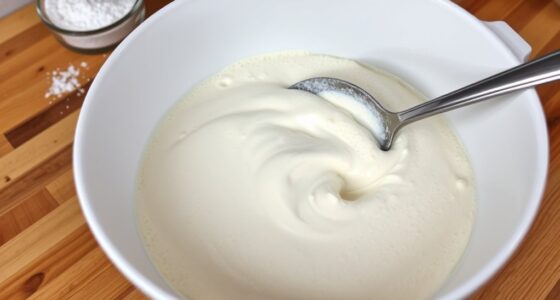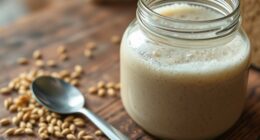When you cut open an avocado, its flesh turns brown because of a natural process called enzymatic browning. This happens when exposing the fruit to air allows enzymes called polyphenol oxidases (PPO) to react with phenolic compounds in the avocado. Oxygen speeds up this reaction, producing brown pigments. The change signals natural chemical activity and doesn’t mean the fruit is spoiled. If you keep exploring, you’ll discover simple tricks to keep it green longer.
Key Takeaways
- Avocado browning occurs when the flesh is exposed to air, triggering enzymatic reactions.
- Polyphenol oxidase (PPO) enzymes react with phenolic compounds, producing brown pigments.
- Cutting the avocado damages cells, releasing enzymes and accelerating oxidation.
- Factors like ripeness, temperature, and oxygen exposure influence the speed of browning.
- Applying citrus juice or wrapping tightly can slow enzymatic browning and preserve color.

Enzymatic browning is a common process that occurs when you cut into an avocado, causing its flesh to turn brown quickly. This phenomenon happens because of an oxidation process triggered by exposure to oxygen in the air. When you slice into an avocado, you break open its cells, releasing enzymes called polyphenol oxidases (PPO). These enzymes interact with phenolic compounds present in the fruit, leading to a series of chemical reactions that result in a color change.
Enzymatic browning occurs when cutting an avocado, causing it to turn brown due to oxygen exposure and enzyme activity.
As the oxidation process progresses, the flesh’s vibrant green shifts toward brown or even black, affecting both its appearance and perceived freshness. The key to understanding why avocados brown lies in the role of the oxidation process. Oxygen molecules from the air penetrate the fruit’s tissue when you cut into it, and the PPO enzymes catalyze reactions between phenols and oxygen.
This enzymatic activity accelerates as the fruit’s cells are damaged, creating a cascade of reactions that produce melanin-like pigments. These pigments are responsible for the characteristic brown color that forms on the surface of the cut avocado. The speed of this color change depends on factors such as the fruit’s ripeness, temperature, and exposure to air. The more exposed to oxygen, the faster the browning occurs.
You might notice that the browning isn’t a sign of spoilage but a natural, chemical response to oxidation. It’s similar to how apples or bananas turn brown after being cut. While the brown color might be undesirable aesthetically, it doesn’t mean the avocado is unsafe to eat. Instead, it signals that the enzymatic activity has reached a point where the phenolic compounds are converting into pigmented molecules.
To slow down this process, you can reduce oxygen exposure by applying citrus juice or wrapping the avocado tightly. These methods help inhibit the oxidation process by creating a barrier against oxygen, thereby maintaining the fruit’s green hue longer. Additionally, understanding the chemical reactions involved allows for better preservation methods. Understanding this enzymatic browning process can help you better manage your avocados. Instead of worrying about the brown spots, recognize that it’s a natural response to oxygen.
An important factor in enzymatic browning is the presence of enzymes and phenolic compounds, which interact during oxidation. By controlling exposure to air, you can preserve the avocado’s appealing color and freshness. Whether you’re preparing guacamole or slicing fruit for a salad, knowing how oxidation influences color change allows you to take simple steps to keep your avocado looking vibrant longer. Remember, this browning is a chemical reaction driven by the enzymes and oxygen, not a sign of poor quality or spoilage.
Frequently Asked Questions
How Can I Prevent Avocados From Browning During Storage?
To prevent avocados from browning during storage, you should use effective storage techniques like squeezing lemon or lime juice onto the cut surface, which adds antioxidants that slow down enzymatic browning.
Wrap the avocado tightly with plastic wrap or store it in an airtight container to reduce exposure to air.
Additionally, keeping it in the refrigerator slows the browning process, helping your avocado stay fresh and green longer.
Is Enzymatic Browning Harmful to Health?
Sure, enzymatic browning might look ugly, but it’s no health concern. The enzyme activity responsible for browning doesn’t produce harmful compounds; it just reacts with oxygen. So, you can enjoy your avocado guilt-free, knowing that that brownish tint isn’t a sign of danger.
Instead, it’s just a natural process, not a sneaky villain lurking in your guacamole. Relax, your health’s safe from this fruit’s little cosmetic mishap.
Do Different Avocado Varieties Brown at Different Rates?
You’ll notice that different avocado varieties have varying browning speeds due to variety differences. Some varieties, like Bacon or Fuerte, tend to brown slower, giving you more time to enjoy them fresh.
Others, like Hass, brown more quickly because of their specific enzyme activity and flesh composition. So, yes, variety differences markedly influence how fast your avocado browns, helping you choose the best type for your needs.
Can Aging Affect the Browning Process of Avocados?
Aging definitely affects how quickly a ripe avocado browns. As it ages, enzymes become more active, speeding up browning during storage.
If you keep a ripe avocado for a longer storage duration, you’ll notice it browning faster once cut. To slow this process, store it properly, ideally in the fridge, and consume it sooner after ripening.
This way, you enjoy its freshness and minimize browning.
Are There Natural Methods to Reverse Browning on Cut Avocados?
If you’re wondering about natural remedies to reverse browning on cut avocados, you can try lemon or lime juice. The acidity slows down enzymatic reactions responsible for browning, helping your avocado stay fresh longer.
Lightly brushing or dabbing the cut surface with citrus juice creates a barrier that reduces exposure to oxygen. These simple tricks harness natural methods to combat enzymatic browning effectively, keeping your avocado looking vibrant.
Conclusion
Now you see, those brown patches are like tiny artists painting over your creamy avocado canvas. But don’t worry—this natural process is just the fruit’s way of aging gracefully. With a little squeeze of lemon or quick toss in the fridge, you can keep that vibrant green alive longer. So, next time your avocado turns, remember it’s simply showcasing its own story of ripening, turning a simple snack into a fascinating tale of nature’s artistry.









